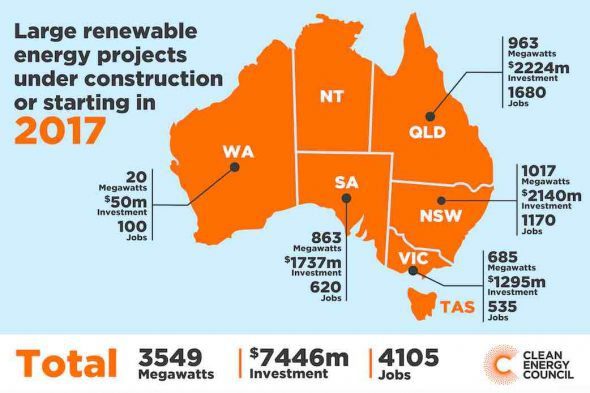The latest data from the Clean Energy Council and the Clean Energy Regulator confirm that Australia is experiencing its biggest ever investment spree in large scale renewable energy, and the 2020 renewable energy target, once considered impossible to meet, is now well within reach.
The CEC on Wednesday released new figures that put the value of large scale wind and solar projects, and one solitary biomass plant, beginning construction in 2017 at $7.5 billion.
The tally, spread evenly around the country, with the exception of Western Australia and Tasmania, represents 3,549MW, with large scale solar overtaking large scale wind, and will result in the creation of 4,105 jobs during the building phase.
See this table for a full list of the projects, put together by the CEC.
More than $2 billion worth of these renewable energy projects have attracted financial commitment in just the last three months, boosted by a string of large-scale solar project announcements since February as solar costs challenge wind energy.
“Large-scale renewable energy, combined with the continued strong uptake of rooftop solar and emergence of energy storage, provides a clear pathway for Australia’s future energy needs,” CEC chief executive Kane Thornton said, adding that new generation was necessary to ensure energy security as coal plants such as Hazelwood retired.
The Clean Energy Regulator also released its own data, which shows that the surge in project announcement, particularly in the more quickly-constructed solar plants, means that the 2020 target is likely to be reached – and a long predicted deficit in large scale certificates in 2018 may also be averted.
The pace is so great that according to executive general manager Mark Williamson, enough projects could be committed by the end of this year to meet the 2020 target – that will be one year earlier than anticipated. Already, 3,300MW has been committed in the last 15 months, and most of it in the last six to eight months and there was a huge pipeline ahead.
The main cause is the push to solar, which is falling in costs and can be built faster. The use of single axis tracking is also increasing its output from around 25 per cent capacity to more than 30 per cent capacity.
“The momentum we saw in the second half of 2016 has continued into 2017. Already we have one-third of the total build required for 2017 achieved in the first four months of the year. If we continue like that, we will get enough commitments by the end of the year. And our market information is that there are some big announcements coming in the net few months.
“This demonstrates that Australia is now in a strong position to meet the 2020 Renewable Energy Target,” Williamson said. To which Wayne Smith, from the Australian Solar Council retorted: “Perhaps we should go back to the original RET target of 41,000GWh.” The target was cut under the Abbott administration.
The fact that the target will likely be met means the current high price of large scale generation (LGC) certificates will fall from their current levels above $80/MWh, a level that has attracted huge interest in the Australian market from international players. Already, it is down to around $76/MWh
Even though the target will largely depend on the action of the major players in the market, particularly the retailers, it suggests the market is doing its job.
The shortage of projects was reflected in the high price, and that has provided a signal for more projects. Hence the target was met. Most project developers would have preferred a more stable policy environment, given the investment drought caused by the uncertainty of the RET under the Abbott government.
Solar is the big focus of development, Of the 98 new power plants above 100kW that were accredited in 2016, 86 were solar, which federal energy minister Josh Frydenberg said reflects the rapidly declining cost and increased capacity of solar PV.
Australia’s energy market is undergoing an unprecedented and unstoppable transformation,” Frydenberg wrote in an article for the Australian Financial Review.
“What is remarkable is the how fast the cost of these new technologies are coming down.” He described this as “good news” and said the technology could be successfully integrated with the right planning.
The CEC, meanwhile, says that there are 35 projects that are already under construction, will start construction or have been completed in 2017.
“Large-scale solar technology has approximately halved in price over just the last few years, making it competitive not only with wind power but with fossil fuels such as gas,” Thornton said.
“Renewable energy is now the cheapest kind of power generation it is possible to build today, and solar power plants have a relatively short project lead time compared to other technologies.
“Regional New South Wales and Queensland in particular will enjoy some of the biggest job and investment benefits, while the Victorian Government’s state target is expected to drive more project activity once finalised and legislated.








